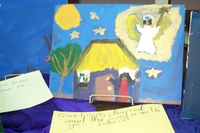She would come early to church, or late as the case would be, and while she was well-dressed, sixty-something, she looked for all the world like a stray cat, too skinny, hungry and big-eyed, more fragile than a person ought to be. I loved the way Elaine climbed into a pew, slipped off her shoes and hugged her knees to herself, staring off into the rafters regardless of what she had walked in on. It seemed as if perhaps she had never been in a church before, though that is hardly possible. Her posture reminded me of Mary and Martha, the sisters of Lazarus, Mary sitting at Jesus’ feet and drinking him in.
That church was in the center of town, and my husband and I called it The Church of the Broken People. Our congregation attracted the newly divorced, a good indicator for a place that claims healing is possible. Elaine wasn’t the first to discover the miracle of it, the warmth of that church at that time, but she embodied the experience of being left behind, forlorn, bereft, like no one else. Starved for goodness, she responded with gratitude to any drop of goodness that could be found, and she found it in the architecture, in the way the light streamed in the window, in the smallest hello.
Prior to the weekly worship service, St. John’s Adult Forum was truly a forum—what we lacked in racial diversity was made up in theological and class diversity, and what congregants believed covered a remarkably broad range. One Sunday, I lead a discussion titled “What is the Bible,” which I introduced with a group cheer:
WHAT is the Bible,
what IS the Bible,
what is THE Bible,
what is the BIBLE—
WHAT, IS, THE, BIBLE?
I made them shout this just to make a ruckus and to loosen up our tongues for the tough questions and differences ahead. I began with a blank flipchart and asked people to tell me what was the biggest, gnarliest question each held in regards to the Bible and modern life. Elaine practically stood out of her seat, shaking with her question when I nodded to her to speak: she blinked as if she might cry and whispered,
“What if… what if it’s real?”
I felt chills as she said it, blood rising to my face in a great rush, and I paused at length to let the question sink in. “Now that,” I nodded, “that is the best question of all, isn’t it? What if this story is true, what if the ending is really good, what if God really cares about us the way this book says, from creation until the end. You win, Elaine! Write that one down.” We proceeded to have the kind of rich, wild discussion one would expect in an Episcopal church where not everyone believes the same thing about the Bible. And every time I saw Elaine after that, I thought of that moment, of magic and vulnerability and grand insight. Every time I saw her I wanted to congratulate her.
Years later I worked in a college office building where Elaine also worked, whole and generous-hearted and capable, not a stray cat at all. And I mentioned Elaine to Gretchen, another member of that community, from that time.
“Now, Elaine, she is a case isn’t she? She never seemed to concentrate on a single word said in church, lost in her own little world. I remember one day she asked in Adult Forum what if the Bible was real, and I wanted to shake her and say, if you’d just pay attention, maybe you’d find out!”
And now it was time for me to be astonished, again, blood rising to my face again, but this time in bewilderment.
“Did you see her face when she said it? You didn’t feel how deep this question was, for her?”
“Deep? The opposite of deep. I just gave up on her. How can a person like that learn anything?”
Now I was discouraged. How could anyone see Elaine that way?
I know my experience. I was present in the room in that Adult Forum, wondering if the Holy Spirit would whisk us all away on a big wind—so was Gretchen, present in the room and permanently discouraged, writing off Elaine as too far gone. You are reading my story, not Gretchen’s, so you will think my side more likely. Which is true?
I am intrigued. It’s perception, interpretation. It’s what we are ready to see. It’s where we have been, along the way, and Gretchen has certainly been some places along the way to see suffering. She is not shallow, not blind at all. I remain convinced of the fire inside the question, convinced I have something to learn from Elaine, to be Mary at the feet of Jesus. But the other perception? I need to know that, too, that mine are not the only eyes in the world, mine not the only view.
Perhaps the lesson for me, once again, and again and again, that others see things differently, feel things differently, even when the Real Version is as plain as the nose on my face, to me. The disparity is unsettling, discordant. And as a writer exploring my own past, this disparity is important. Is my version true? Has my memory embellished it?
In the case of Elaine, she seems vibrant, now, and thrilled when I bring her a yellow tulip for her office. As for me, I laugh and shake my head. Regardless, I like my version better, and I’m sticking to my story.
What if it’s real? Isn’t that the best question of all! What if.



